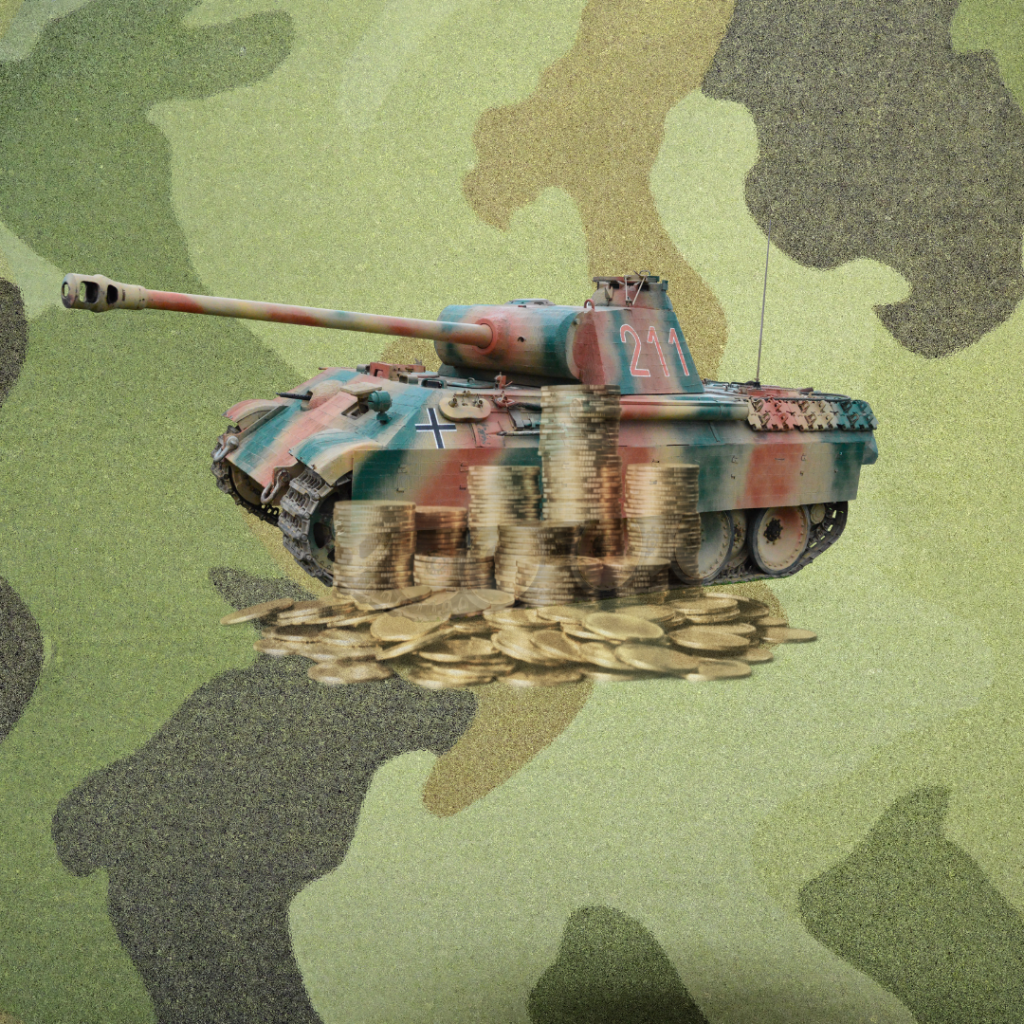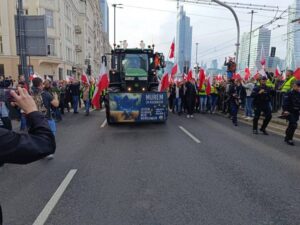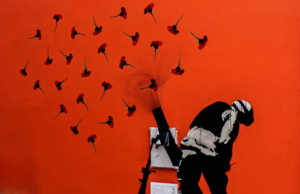Gabriele Michalitsch looks at developments in Austria to explain how neoliberalism is continuing to affect our economies and societies while creating fertile ground for authoritarianism.
War and inflation are casting a dark shadow over Europe. The narrative being sold by politicians and the media about a war being fought by “democracies” against their “enemies” – and for which we must therefore pay – belies the fact that rising authoritarianism is also a phenomenon in European societies.
Even in the supposedly free West, inflation and conflict are strengthening authoritarian tendencies: by driving social polarisation and social exclusion, these shifts accelerate the loss of democracy, while a friend/enemy dualism and the idea of masculine toughness are starting to influence government policy.
Lessons from the past: hyperinflation
In 2022, Austria saw record average annual inflation of 8.6% – a figure last seen in 1974 during the oil price shock. As inflation had been below four per cent since 1992, some are now evoking a century-old spectre that once haunted the nation: hyperinflation. A number of recent publications on the hyperinflation that took hold in Austria and Germany during the 1920s (peaking in 1922 and 1923 respectively) warn that soaring price rises could lead to political radicalisation; after all, hyperinflation was partly responsible for Hitler’s attempted coup in November 1923.
Although this period of hyperinflation and its disastrous social and political impacts are ingrained in our collective memory, it seems misleading to make such a historical comparison. Back then, Austria was facing monthly inflation of around 130 per cent; in Germany, this figure stood at around 30,000 per cent. In the last six months of 1923, the price of one egg increased from a few hundred to several billion marks. At the peak of inflation, prices in Germany would rise multiple times in just a single day. The financing of the First World War, mass printing of bank notes to meet reparation payments and the catastrophic economic situation facing newly formed nation states in the aftermath of military defeat also accelerated currency devaluation.
But even if current events are very different from the hyperinflation of the 1920s, the impact rising prices are having on our societies, our political climate and our democracies is still deeply concerning. Poverty, inequality and social exclusion are on the rise; deepening social rifts are further eroding the foundations of democracies already shaken by decades of neoliberal transformation.
Price and profit
The war in Ukraine and the EU’s subsequent sanctions against Russia are considered to be two of the main culprits behind the jump in inflation as these events have inflated energy prices that have been on the rise since 2020. Other factors often cited are Covid-19 (i.e. consumers building up savings during repeated lockdowns and then the resulting spike in demand once restrictions were lifted) and supply chain issues as well as the European Central Bank’s low interest rates and cheap loans. At the same time, the inflation we are witnessing is – at least, in part – a “process of enrichment” as businesses enact price rises that are several times higher than their actual cost increases. For instance, the prices of milk and milk products, where energy makes up less than 5 per cent of the total production cost, have risen by up to 50 per cent. Alongside raw materials and food, property prices and rent have, for some time, been driving inflation and causing the price of basic necessities to rise: “housing, electricity, gas, fuel and food. Here generating higher profits through price hikes is especially easy as these are things consumers simply cannot live without.” Inflation is therefore also exacerbating the class struggle, but with few winners and many losers.
Unequally distributed support
As the cost of energy and food are rising most rapidly, those on the highest incomes are less impacted by inflation than those on the lowest incomes. For example, those on the lowest 20 per cent of incomes experienced an 11.8 per cent price hike in October 2022, while for those in the top 20 per cent, this increase was 10.7 per cent. In an attempt to lessen this cost-of-living gap, politicians are generally choosing to suspend energy taxes and offer universal payments to help with rising prices, especially to poorer households, who also receive one-off transfers. Although the range of measures are providing vital support that generally benefits the lowest earnings decile and lower income groups more than top earners, it begs the question whether cost-of-living support for the top third of earners is socially necessary or even makes good economic sense.
Yet there is a huge discrepancy between government support for households and businesses. In Austria, support payments to companies is undoubtedly the government’s largest single measure to tackle the effects of inflation: €7 billion have been earmarked for the scheme – and there is, in effect, no upper limit. The state is essentially offering subsidies of up to €4 million to every company and is not demanding anything in return (businesses are not even required to show proof of losses). In certain circumstances, this figure could be as high as €150 million. As was shown several times during the pandemic, the design of these support schemes often inevitably leads to overpayment, and inflation support measures thus simply become state-subsidised corporate profit.
Despite windfall taxes, energy companies are raking in considerable profits, especially since Austria’s tax on excess profits, which – depending on future energy prices – is predicted to generate between two and four billion euros for the public coffers, is still lagging far behind the tax rates agreed by the European Commission: a maximum 40 per cent windfall tax will only be applied to profits that exceed 20 per cent of a company’s average profits over the past three years.
In total, households can (provisionally) expect to receive over €11 billion in support during 2022 and 2023; businesses will receive around €9 billion. The distributional effects of the many payments being made will ultimately also depend on how these measures are funded. At present, workers are contributing around two thirds of overall (federal) tax revenue through income tax and a considerable portion of a regressive sales tax, while the business sector makes a relatively small contribution of around 10 per cent through corporation tax. This tax has been gradually lowered from 25 to 23 per cent since the start of the year, further decreasing the amount of government revenue raised this way. Ultimately, it is not only workers but the unemployed and pensioners who are funding their own cost-of-living payments – and those of businesses, too.
Poverty and social exclusion
Inflation also significantly erodes people’s earnings. In 2022, Austria recorded a loss in real earnings of over 4 per cent; in Germany, the figure was just under 3 per cent.[1] Wage agreements for 2023, most of which include increases of 7-8 per cent, will not fully compensate for such significant real-term losses, which will ultimately benefit employers.
This issue is compounded by a drop in the value of social transfers. State pensions will rise by 5.8 per cent in 2023 but pensioners will still lose a considerable amount of purchasing power. A number of – primarily family-focused – social transfers have also been increased, with the exception of (reduced-rate) unemployment benefits, even though the (long-term) unemployed are one of the groups most severely impacted by poverty.
Last autumn more than half of Austrians were already worrying about whether they would be able to heat their homes; more than 40 per cent were also concerned that further price rises would push them into debt.[2] Although we will only see the full impact of inflation on bankruptcy this year, 2022 figures were already almost 25 per cent higher than in 2021, and the number of applications for bankruptcy has risen by more than 28 per cent.[3]
Meanwhile, poverty remains rampant, as shown by the number of food parcels handed out by Caritas, Austria’s largest Catholic charity group. In 2022, the charity gave away roughly 50 per cent more food than at the height of the pandemic in 2021, i.e. 26 tonnes per week, up from 17. In fact, demand was so high that in autumn the amount of food items per household had to be reduced and the service closed to new applicants.
Interest rate policy and stagflation
The real-term drop in earnings, and especially in pensions and unemployment benefits, as well as the redistribution of wealth from the bottom to the top are associated with a fall in demand and thus act as a drag on economic growth.[4] At the same time, the US Federal Reserve, followed by the European Central Bank[5], has responded to the crisis by putting up interest rates. As interest rate rises increase the price of, and thus deter, investment, they also put downward pressure on the economy, which – as last seen during the oil crisis of the 1970s – is likely to lead to stagflation, i.e. slow economic growth together with growing unemployment and high inflation.[6]
Division and the erosion of democracy
Inflation and policies to bring it under control thus exacerbate existing asymmetries between labour and capital, gender hierarchies relating to finance and racialised economic divisions. They entail a considerable redistribution of wealth from the bottom to the top, reinforce social inequality and further intensify social polarisation. The foreseeable rise in unemployment as a result of stagflation will once again hit the most vulnerable the hardest: the unemployed, those in precarious work, low earners – all of whom are disproportionately women and migrants. Existing disparities, poverty and exclusion as well as class, gender and racial divides will become even further entrenched and thus continue to undermine the democratic foundations of society.
Rearmament and militarisation
Yet while social inequality and economic hardship are intensifying dramatically, the world is once again increasing its military spending. Germany has renewed its ambition to become a military power, and even in the “perpetually neutral” state of Austria, which has a close relationship with NATO despite not being a member, militarisation is taking place. The country’s 2023 defence budget has risen by €680 million to €3.3 billion so that – if pensions paid to former members of the armed forces are included – it now equates to 1 per cent of the country’s GDP. In the years to come, further increases are planned and have been written into a special military funding law which ensures that at least 1.5 per cent of GDP is spent on defence from 2027.
The government is taking advantage of attitude shifts at home: only around half of Austrians feel “very” or “rather safe”, partly in response to the war in Ukraine, down from more than 70 per cent in 2021. However, for some time now the public discourse has been dominated by enemies both domestic and foreign that have been constructed by politicians and the media, such as terrorists, refugees and “others”. The list now includes climate activists, Russia and China. The term “safety” has long been disassociated from the welfare state and placed into a police/military context. It is thus hardly remarkable that support for the armed forces has reached a new high. In a recent survey, 63 per cent were in favour of higher military spending (an eight-percentage-point rise compared to 2021), while 56 per cent (13 percentage points higher than in 2021) and for the first time ever, a majority, even support increasing the number of soldiers.[7]
Neoliberal toughness and far-right militants
Danger seems to be lurking around every corner. Indeed, not only is the gap between the ever-inflating wealth of a few and the growing poverty of many getting worse, so too are the everyday battles for survival. The dominance of neoliberalism has also paved the way for a “culture of strength”[8] in which ruthless competition and individual responsibility have evolved into basic social principles. Neoliberalism’s survival-of-the-fittest mentality has also turned both the unopposed and antisocial adaptation to market conditions for the sake of profit maximisation into a matter of survival. With competition governing every aspect of life, the flaws and woes of others have become positive signals that, in this world of universal competitiveness, appear to offer us the promise of power and greater opportunities.[9]
However, as competition by definition allows only a handful of “winners”, frustration and aggression rise. Far-right leaders offer an outlet for all the built-up, destructive feelings of powerlessness: the socially vulnerable, constantly denigrated “others” and “enemies”. They give people a reason to (as they see it) rightly stand up and invoke their own superiority – especially through the collective “we” of a national community – that can be used to confront not only those seeking refuge from conflict as well as economic and environmental destruction, but also the “enemies of democracy” in the “autocracies of the East”. When surrounded by enemies, however, a country needs “men of action” who are willing to fight and put “the others” in their place – behind electrified fences, walls topped with barbed wire or the four walls of their own homes, to mark the country’s insurmountable borders and make it clear, once and for all, who the real masters are.
Perhaps a comparison with 20th-century hyperinflation isn’t too misguided after all.
References/Remarks:
[1] Lübker, Malte/Janssen, Thilo (2022): ‘Europäischer Tarifbericht des WSI – 2021 / 2022. Tarifpolitik im Zeichen von Krise, Krieg und Inflation’, WSI Report, No. 77, August 2022, 13. Data for 2022 are based on a forecast by the European Commission. Real earning losses of more than 8 per cent are predicted for Czechia.
[2] A third of parents are cutting back on activities for their children (e.g. private tutoring), which shows how long-term exclusionary effects will impact multiple generations. Austria’s SORA social research institute conducted 1,011 interviews between September and early October 2022.
[3] This significant increase can be partly explained by changes from 2020 and 2021 filtering through to the data and reforms to the Austrian Insolvency Act that came into force in 2021.
[4] Those on lower incomes tend to consume more than those on higher incomes as they are forced to spend (almost) their entire earnings on basic necessities. A large portion of this money is transferred to property owners or other rentiers whose additional earnings are seldom used for consumption.
[5] In order to prevent larger outflows of capital to the US, the ECB is being forced to enact the same policy as the Federal Reserve.
[6] Heiner Flassbeck, who was the UNCTAD’s chief economist for several years, has emphatically warned against interest rate rises, which, alongside stagflation, will trigger a serious debt crisis, especially in the Global South.
[7] The Austrian armed forces thus received the highest approval ratings since the study (which is conducted by Market-Institut) was first commissioned by the Ministry of Defence in 2019.
[8] Fach, Wolfgang (2000): ‘Staatskörperkultur. Ein Traktat über den "schlanken Staat"‘, in: Bröckling, Ulrich/Krasmann, Susanne/Lemke, Thomas (eds): Glossar der Gegenwart, Frankfurt am Main, 121.
[9] See Ottomeyer, Klaus (2004): Ökonomische Zwänge und menschliche Beziehungen. Soziales Verhalten im Kapitalismus,Münster, 71f.



